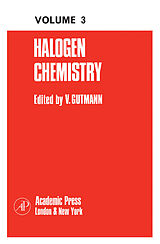Halogen Chemistry
Format:
E-Book (pdf)
EAN:
9780323148474
Genre:
Chemie
Herausgeber:
Elsevier Science & Techn.
Anzahl Seiten:
486
Erscheinungsdatum:
02.12.2012
Halogen Chemistry, Volume 3 focuses on advancement in the study of halogens.
Composed of contributions of authors, the book focuses on discussions on halides that contain multicentred metal-metal bonds. The discussions are initialized with an introduction; identification of factors that influence metal-metal bond formation; and compounds that contain multi-centred metal-metal bonds. The text also looks at the nature of metal-halogen bonds and the metal-halogen vibrational frequencies. Numerical representations and tabulations are presented as well.
The book also looks at the halides of niobium and tantalum. Concerns include fluorine, chlorine, bromine, and iodine compounds. The compilation further considers pentahalides of transition metals and halide chemistry of chromium, molybdenum, and tungsten. The book closes with discussions on halogen chemistry of actinides and halogeno metal carbonyls and related compounds. Covered areas include trivalent, tetravalent, pentavalent, and hexavalent actinides, and structures and reactions of halogeno metal carbonyls.
The compilation is a valuable source of information for readers interested in the study of halogens.
Inhalt
Contributors to Volume 3
Preface
Contents of Volumes 1 and 2
Halides Containing Multicentered Metal-Metal Bonds
1. Introduction
2. Factors Influencing Metal-Metal Bond Formation
3. Compounds Based on the (M6X12)2+ Core
A. Introduction
B. Monomeric Complexes
C. Binary Halides
D. Magnetism, Spectra and Bonding
4. Compounds Based on the (M6X8)4+ Core
A. Introduction
B. Monomeric Complexes
C. Binary Halides
D. Spectra, Magnetism and Bonding
5. Compounds Based on the (Re3X3)6+ Core
A. Introduction
B. Monomeric Complexes
C. Binary Halides
D. Spectra, Magnetism and Bonding
6. Other Compounds Containing Multicentered Metal-Metal Bonding
A. Introduction
B. Halogen Bridges
C. Oxygen Bridges
D. No Bridging Atoms
References
The Nature of Metal-Halogen Bonds
1. Introduction
2. Experimental
A. Neutral Molecules
B. Complex Ions
3. Tables of Coordinate Bond Energies
A. Neutral Metal Halides
B. Metal Halide Complex Anions
4. Other Properties Related to Bonding
A. Electron Spin Resonance
B. Nuclear Magnetic Resonance Chemical Shifts
C. Nuclear Quadrupole Resonance
D. Decrease in Spin-Orbit Coupling Constants
E. Decrease in Inter-electronic Repulsion Integrals: The Nephelauxetic Effect
F. Dipole Moments
G. Force Constants
H. X-Ray Diffraction
5. Theoretical
A. The Hard Sphere Ion Model
B. Polarizable Ion Model
C. Localized Molecular Orbital Method
D. Modified Wolfsberg-Helmholz Method
References
Review of Metal-Halogen Vibrational Frequencies
1. Introduction
2. Metal-Fluorine Vibrational Frequencies
A. Octahedral Molecules
B. Tetrahedral Molecules
C. Heptafluorides
D. Other Stereochemistries
E. Assignments in Metal Complexes
3. Metal-Chlorine, Metal-Bromine, and Metal-Iodine Vibrational Frequencies
A. Octahedral Hexahaloanions
B. Tetrahedral Anions
C. Square Planar Ions
D. Five-Coordinate Halides
E. Linear Species
F. Assignments in Metal Complexes
4. Conclusion
References
The Halides of Niobium and Tantalum
1. Fluorine Compounds
A. Pentafluorides
B. Sub-Fluorides
2. Chlorine Compounds
A. Pentachlorides
B. Sub-Chlorides
3. Bromine Compounds
A. Pentabromides
B. Sub-Bromides
4. Iodine Compounds
A. Pentaiodides
B. Sub-Iodides
References
Pentahalides of the Transition Metals
1. Introduction
2. Pentahalides
A. Physical Properties and Structure
B. Preparation of the Pentahalides
C. Chemical Properties
3. Mixed Pentahalides
References
Halide Chemistry of Chromium, Molybdenum and Tungsten
1. General Introduction
2. Chromium
A. Chromium(I) (d5)
B. Chromium(II) (d4)
C. Chromium(III) (d3)
D. Chromium(IV) (d2)
E. Chromium(V) (d1)
F. Chromium{VI) (d0)
3. Molybdenum and Tungsten
A. Molybdenum and Tungsten (0,I)(d6,d5)
B. Molybdenum and Tungsten (II)(d4)
C. Molybdenum and Tungsten (III)(d3)
D. Molybdenum and Tungsten (IV)(d2)
E. Molybdenum and Tungsten(V)(d1)
F. Molybdenum and Tungsten(VI)(d0)
Recent Developments
References
The Halogen Chemistry of the Actinides
1. Introduction
2. The Trivalent Actinides
A. General Chemistry
B. Trifluorides
C. Trichlorides
D. Tribromides
E. Tri-Iodides
F. Mixed Halides
G. Oxyhalides
3. The Tetravalent Actinides
A. General Chemistry
B. Tetrafluorides
C. Tetrachlorides
D. Tetrabromides
E. Tetraiodides
F. Mixed Halides
G. Halo Complexes
H. Oxyhalides
4. The Pentavalent Actinides
A. General Chemistry
B. Pentafluorides
C. Intermediate Fluorides
D. Pentachlorides
E. Pentabromides
F. Pentaiodides
G. Mixed halides
H. Halo Complexes
J. Oxyhalides
5. The Hexavalent Actinides
A. General Chemistry
B. Hexafluorides
C. Uranium Hexachloride
D. Oxyhalides
References
Halogeno Metal Carbonyls and Related Compounds
1. Introduction
2. Methods of Preparation
A. Copper Subgroup
B. Nickel Subgroup
C. Cobalt Subgroup
D. Iron Subgroup
E. Manganese Subgroup
F. Chromium Subgroup
3. Chemical and Physical Properties
4. Structures of Halogeno Metal Carbonyls
A. X-Ray Determinations
B. Structure Investigations by Physical Methods
5. Reactions of Halogeno Metal Carbonyls
A. Mononuclear Compounds
B. Polynuclear Compounds
C. Anionic Compounds
6. Mechanistic Studies
7. Stability of Halogeno Metal Carbonyls
References
Author Index
Subject Index

Leider konnten wir für diesen Artikel keine Preise ermitteln ...
billigbuch.ch sucht jetzt für Sie die besten Angebote ...
Die aktuellen Verkaufspreise von 2 Onlineshops werden in Realtime abgefragt.
Sie können das gewünschte Produkt anschliessend direkt beim Anbieter Ihrer Wahl bestellen.
Loading...
Die aktuellen Verkaufspreise von 2 Onlineshops werden in Realtime abgefragt.
Sie können das gewünschte Produkt anschliessend direkt beim Anbieter Ihrer Wahl bestellen.
| # | Onlineshop | Preis CHF | Versand CHF | Total CHF | ||
|---|---|---|---|---|---|---|
| 1 | Seller | 0.00 | 0.00 | 0.00 |
